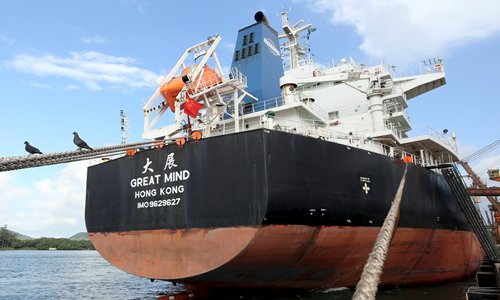
A ship from China loaded with soybeans docks at a port in Brazil. File photo: VCG
China is taking a mutually beneficial approach to economic cooperation with Latin America and the Caribbean, while the US is seeking to preserve its dominant position in the region under its protectionist "America First" strategy, two Chinese experts said on Monday.
The experts, who specialize in China's foreign trade and Latin America policies, were responding to recent comments from US Secretary of State Rex Tillerson, who suggested that China's economic and trade activities in South America are "new imperial powers" and that Chinese investment in the region would come at "a price."
In a speech on Thursday ahead his first visit to the region as the top US diplomat, Tillerson said that "Latin America does not need new imperial powers that seek only to benefit their own people. China's state-led model of development is reminiscent of the past. It doesn't have to be this hemisphere's future."
"Such accusations are completely baseless and ignorant of the facts," Chen Fengying, an expert at the China Institutes of Contemporary International Relations, told the Global Times. Chen pointed out that it is the US that has long viewed Latin America and the Caribbean as its backyard and has acted accordingly.
"If any country is taking advantage of Latin America, it's the US, and it has been for a long time."
In his speech, Tillerson alluded to China's surging investment and trade cooperation with countries in Latin America and the Caribbean.
However, despite fast growth in recent years, Chinese investment in the region still falls far behind that of the US.
In 2016, even after taking mergers and acquisitions into account, China only ranked as the fourth-largest investor in Latin America and the Caribbean, after the US, the EU and Canada, according to the latest report on foreign direct investment in Latin America and the Caribbean from the UN's Economic Commission for Latin America and the Caribbean released in August 2017.
Without mergers and acquisitions, China only accounted for 1.1 percent of foreign direct investment into the region, while the US accounted for 20 percent and the EU accounted for 53 percent, the report said.
This indicates that the US and the EU are far more eager to exploit Latin America and the Caribbean than China, Chen said.
Win-win model
The growth of Chinese investment in Latin America and the Caribbean has been boosted by a mutually beneficial model of bilateral cooperation, Guo Cunhai, deputy director of Latin American Studies at the Chinese Academy of Social Sciences, told the Global Times on Tuesday.
"If this was not mutually beneficial or not welcomed by countries in the region, there is no way Chinese investment could rise so fast," Guo said. "Whether or not cooperation with China is beneficial for Latin America should be decided by people in the region, not by a US official."
Tillerson in his speech warned against China's model of economic development, saying "China - as it does in emerging markets throughout the world - offers the appearance of an attractive path to development. But in reality, this often involves trading short-term gains for long-term dependency."
Guo said that China's policy is clear: "We are seeking equal, fair economic and trade cooperation without any conditions or interference in the countries' sovereignty or political issues."
That is in stark contrast with the US model, which often comes with strict conditions and political interference, Guo said.
"Just look at this speech and others Tillerson gave during his trip to Latin America: It's basically him telling Latin American countries what they should or should not do."
Guo also said this kind of approach might be the reason why the US "has been so negatively viewed, not just in Latin America but around the world, and blaming China is not going to change that."


